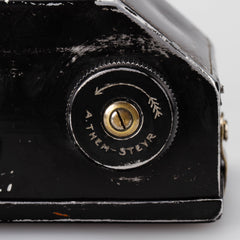A. Them-Steyr, Photosport, c.1925
Much has been written about the early days of 35mm photography and the associated camera technology.
35mm film (also referred to as normal film) is a film format in which the filmstrip is 35mm wide. It was originally developed to record moving images and only later used in still photography. In both areas, it became the predominant film format.
At the beginning of the twentieth century, there were various attempts to construct photo cameras for the use of the perforated cinema film with a 35mm width. Oskar Barnack then developed the first prototype of such a cameras for Leitz in 1913 (the so-called Ur-Leica).
It was not clear from the start that this camera invented by Barnack, which was further developed only a few years after the end of World War I to be launched in 1925, would become a worldwide success.
Apart from Leitz, several other manufacturers began using the perforated 35mm film for smaller, handy cameras in the 1920s. By means of the also newly introduced enlargers, corresponding prints could be made.
All of these early 35mm cameras was manufactured by small companies, who weren’t able to survive in the long run. Therefore, today most of these cameras are rare or very rare and popular collector's items.
Cameras such as the Homeos, the Sico, the Simplex, the Minigraph, the Phototank, the Esco, the Eka, and the Rothschloss among others are fascinating constructions, which were significantly involved in the progress of 35 mm photography.
There were also very interesting developments in Austria. For example, the company Ö.T.A.G/ (Österreichische Telefon Aktien Gesellschaft) built a simple 35 mm camera called the Amourette. A prototype of this camera and virtually all its variants (with various lenses and shutters) are on view at WestLicht Museum.
A second company, the Apparate G.m.b.H., introduced a very similar camera to the market at the same time, the Photorette, which compared to the Amourette however was not a big success and therefore was only produced in small numbers.

Thus, even more remarkable is the discovery of yet another Austrian 35mm camera. As a chance find and gift to the museum, WestLicht received an A.Them-Steyr, Photosport, which after long research turned out to be a major rarity. There is only one other known image of such a camera, published in Michel Auer, The Guide to Antique Cameras, no.1420.


This camera is very similar to the Amourette, just slightly larger. It produces 24x30 mm images on perforated 35 mm film in special cassettes. The lens is a Laak Dyalitar Anastigmat 4.5/45mm no.57545 in Dial-set Compur shutter (this type of lens was also used in some Amourette cameras). The serial number is 108, so most likely it is the 9th camera made about 1925.


It was probably invented and produced by Karl Them (1888–1966), who ran the first camera shop in Steyr (Upper Austria). He was a painter, photographer, and alpinist.


Since there are only two examples known to exist, the Photosport is the rarest early 35 mm camera and I am very glad to introduce it in my blog and in the permanent WestLicht Camera Museum exhibition.


I look forward to showing you more fascinating cameras on this platform and am very interested to hear your comments.
All the best,
Peter Coeln


5 Comments
I need hard work and kashmir one person
Bhoote shock hai
Grossartig !
ein grund mehr für mich jetzt doch endlich mal ins westlicht zu gehen und zu schmökern.
Großartig, Peter!
Ich komme ja aus Steyr und diverse Portraits meiner Jugendjahre – wie auch mein erstes Führerscheinbild – wurden im Studio Them angefertigt. Dass Herr Them selbst eine Kamera gebaut hat, war mir bisher nicht bekannt. Die muss ich mir mal ganz genau im Westlicht ansehen. Liebe Grüße, Gerhard
Kameras sind Wächter der Zeit.
Danke Peter “CC” für diesen interessanten Einblick in die Zeit-Geschichte der Kameratechnik. Go ahead!